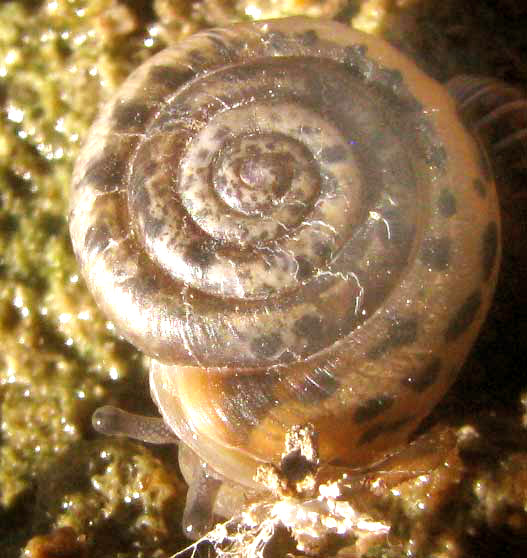Excerpts from Jim Conrad's
Naturalist Newsletter
from the December 1, 2013 Newsletter issued from the Frio Canyon Nature Education Center in the valley of the Dry Frio River in northern Uvalde County, southwestern Texas, on the southern border of the Edwards Plateau; elevation ~1750m (~5750 ft); N29.62°, W99.86°; USA
FLATCOIL SNAIL
Recent rains have the little Dry Frio River more or less flowing again. This week, on a gravel bar in the river, beneath an alga-encrusted rock resting atop pebbles with water trickling through them there was a snail about the size of the fingernail of a pinky finger. Field marks making it a little unusual included its several, tightly coiled rings, the manner in which the whorls were compressed into a flattish shell, and the pale brown shell's numerous dark spots. Below, you can see it, its stalked eyes at the lower left:

In snail identification the basic starting point is knowing whether your snail lives on dry land, in freshwater, or is marine. Our Dry Frio snail wasn't marine, but I couldn't say whether its position on a rock's wet bottom with water running among pebbles beneath the rock qualified it as a land snail or a freshwater one.
Happily, on the Internet a fine website turned up at Molluskman.com, dedicated to the study of mollusks in the Houston, Texas area. The man at Molluskman.com is Max Anton, a young, amateur artist and malacologist who volunteers a good bit at the Houston Museum of Natural Science. Max offers to identify snails. Seeing ours, he replied:
"I'm pretty sure the snail you photographed belongs to the terrestrial species Polygyra cereolus, but it might be something else. I'd need to see the aperture to make a definite ID, but I know for certain that it's a member of the Polygyra family. They're a native species that typically poses no threat to healthy plants or agriculture."
So, there you are. I offered to ID plants for Max in return for his help with snails, so maybe we have a future together.
If our snail is POLYGYRA CEREOLUS -- and it matches pictures of that species on the Internet -- one common name for the species is the Southern Flatcoil Snail, and it's an air-breathing land snail. It's been reported mostly in the US southeastern states, Mexico, and the Caribbean, and has been observed feeding on Red and White Clovers, though no clovers were near where I found ours.
The family to which Southern Flatcoils belong, the Polygyridae, contains many of eastern North America's land snail species, with a few other species scattered across western North America, Mexico and northern Central America, and the Caribbean. It's interesting to note the features experts use in distinguishing the family: Members have no "love dart"; muscles used to retract the eyes and pharynx are united into a single band, and; the jaws are ribbed. The "love dart" is such a bizarre feature of many snail types that if you want to know more you can visit Wikipedia's Love Dart Page at https://en.wikipedia.org/wiki/Love_dart.
Anyway, in the above list of features of the Polygyridae, notice that there's no mention of the shell. Features used are those you'd never see unless you cut your snail apart beneath a dissecting scope.